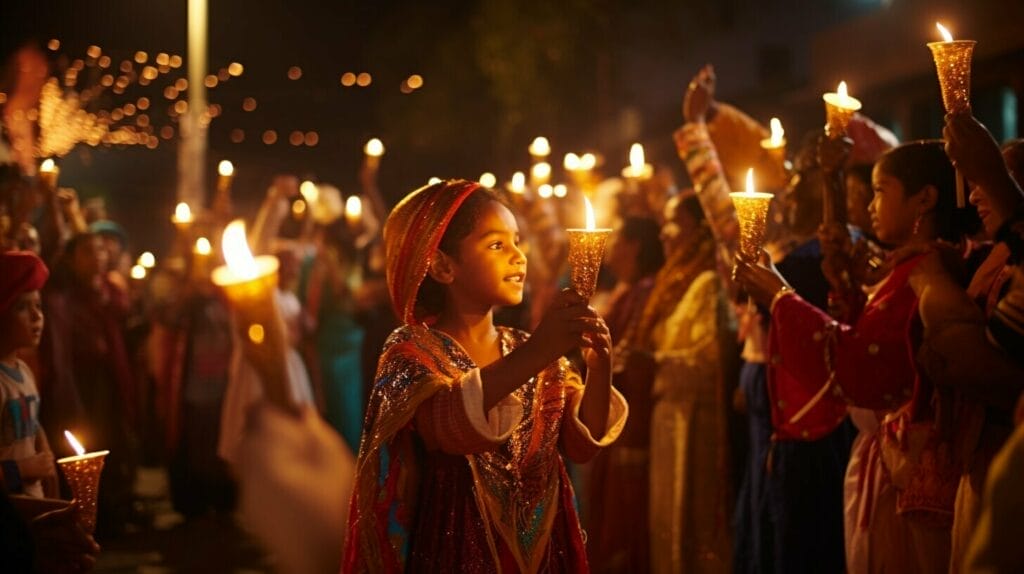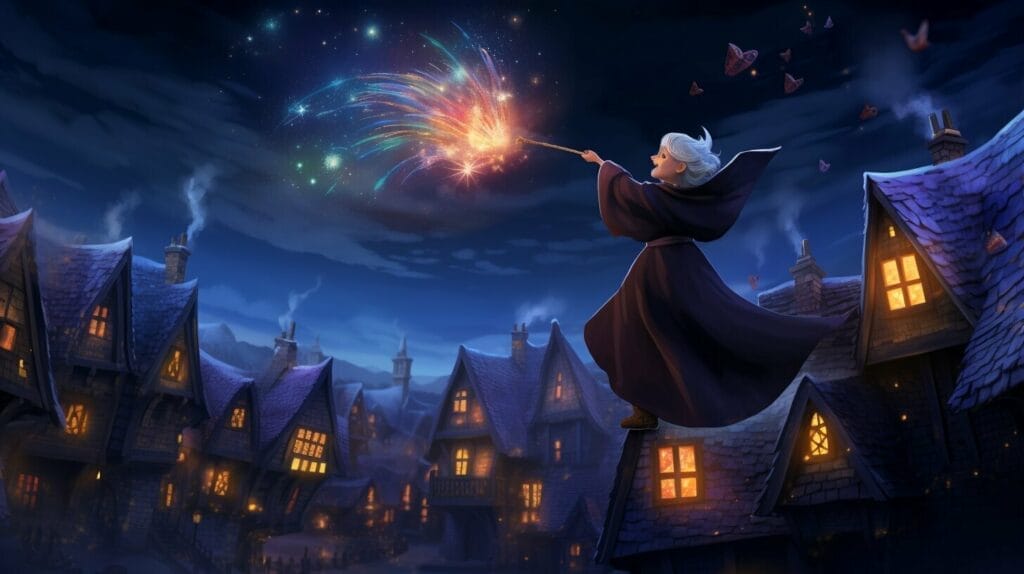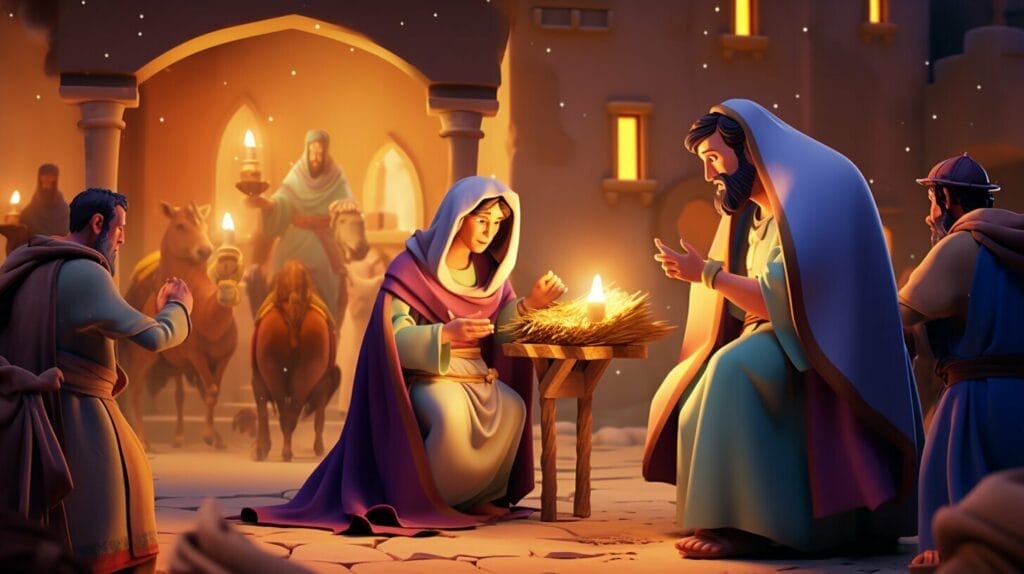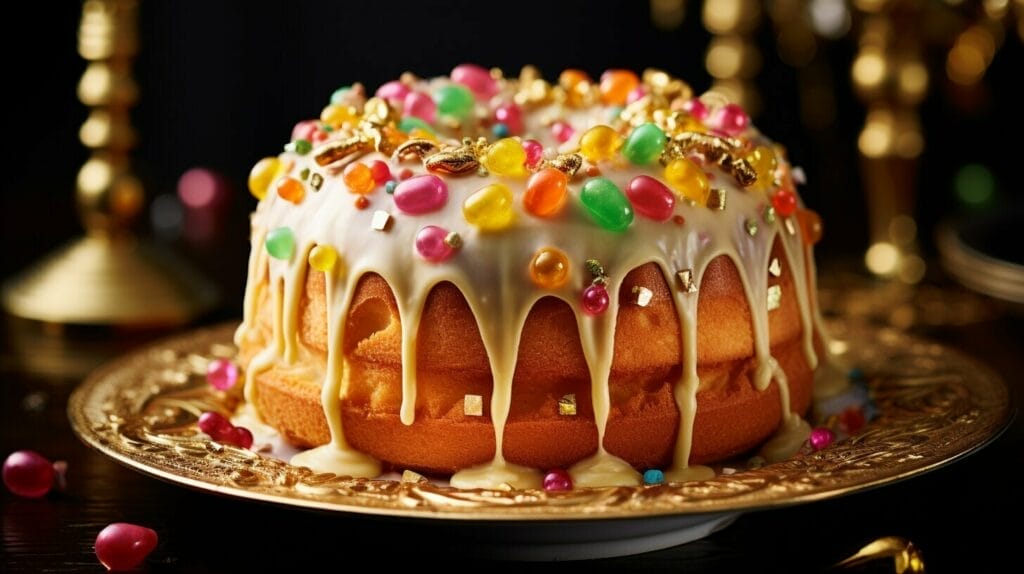The Meaning and Customs of Epiphany or Three Kings’ Day
As the Christmas season comes to an end, the celebration continues with Epiphany, also known as Three Kings’ Day. This Christian feast day, observed on January 6th, commemorates the manifestation of Jesus Christ to the world. The observance of Epiphany is marked by various customs and traditions worldwide.
On Twelfth Night, the night before Epiphany, many cultures gather for Epiphany celebrations, often involving feasting, singing, and exchanging gifts. From the cutting of the Epiphany cake to reveal a hidden figurine to the Adoration of the Magi, there are many unique customs and rituals that take place during this festive time.

Key Takeaways
- Epiphany is a Christian feast day observed on January 6th.
- The celebration commemorates the manifestation of Jesus Christ to the world.
- Epiphany is marked by various customs and traditions worldwide.
- Twelfth Night, the night before Epiphany, is often a time for feasting and exchanging gifts.
- Unique customs associated with Epiphany include the cutting of the Epiphany cake and the Adoration of the Magi.
The Story of the Magi and the Star of Bethlehem
Lets travel back in time to discover the incredible story of the Magi, also known as the Wise Men, and their journey to see the baby Jesus. According to the Bible, these three wise men from the East saw a bright star in the sky, which they interpreted as a sign of the birth of a new king. They followed the star and arrived in Bethlehem, where they found Mary, Joseph, and the newborn Jesus.
The Magi presented the baby with gifts of gold, frankincense, and myrrh, which symbolized his kingship, divinity, and eventual sacrifice. This biblical story is celebrated during Epiphany, which is also known as Three Kings’ Day and falls on January 6th, marking the end of the Christmas season.
Many depictions of the Magi show them riding on camels, dressed in luxurious clothing, and carrying their gifts. The image of the three Wise Men has become a popular symbol of Christmas and Epiphany, and their journey continues to inspire people around the world.

The Star of Bethlehem is a significant symbol in the story of the Magi. It is said to have guided the Wise Men on their journey, leading them to the birthplace of Jesus. The star is often depicted as a bright, shining light in the sky, representing hope and divinity.
Some scholars believe that the Star of Bethlehem may have been a rare astronomical event, such as a conjunction of planets or a comet. Others suggest that it was a divine miracle, sent by God to herald the birth of his son.
The Significance of the Gifts
The gifts presented by the Magi have deep symbolic meaning. Gold is a precious metal that represents kingship and wealth. Frankincense is a fragrant resin that was used in ancient times in religious ceremonies, symbolizing the divinity of Jesus. Myrrh is an aromatic resin that was used as an embalming oil, foreshadowing the death and sacrifice of Jesus.
The gifts of the Magi have become a popular part of Christmas and Epiphany celebrations. Many cultures around the world exchange gifts during these holidays, emulating the generosity and spirit of the Wise Men.
“We three Kings of Orient are
Bearing gifts, we traverse afar.”
– From the Christmas carol “We Three Kings”
Now that you know more about the story of the Magi and the Star of Bethlehem, you can truly appreciate the deep symbolism and spiritual significance of Epiphany. As you celebrate this special holiday, take a moment to reflect on the journey of the Wise Men and the message of hope and faith that they represent.
Epiphany Traditions Around the World
Epiphany, also known as Three Kings’ Day, is celebrated around the world with various traditions and customs. In Italy, children look forward to a visit from La Befana, a benevolent witch who delivers gifts to good children on the eve of Epiphany.
In Spain and Latin America, the Rosca de Reyes, a sweet bread decorated with candied fruit and a hidden figurine, is enjoyed. Whoever finds the figurine in their slice is crowned king or queen for the day and must host the next celebration.
The cutting of the Epiphany cake, also known as King Cake, is a tradition in some cultures, such as France and Belgium. A hidden trinket or bean is placed inside the cake, and the person who receives the slice with the trinket is said to have good luck in the coming year. Eastern Orthodox churches also have their own unique celebrations, including special liturgies and Epiphany hymns.
| Country | Epiphany Tradition |
|---|---|
| Italy | Gifts from La Befana |
| Spain and Latin America | Rosca de Reyes |
| France and Belgium | Epiphany cake with hidden trinket or bean |
| Eastern Orthodox Churches | Special liturgies and Epiphany hymns |
Despite the differences in these traditions, they all serve as reminders of the importance of the Epiphany, the manifestation of Christ to the world. They serve to bring families and communities together to celebrate the joy and wonder of this special day.

Epiphany is a time for grand processions and vibrant celebrations. One of the most significant events during this time is the Adoration of the Magi, where reenactments of the three kings’ visit to baby Jesus are performed. This tradition dates back to the Middle Ages and is still upheld in many cultures today. During the procession, participants dress up as the Magi and carry gifts, while others play instruments and sing carols.
Epiphany processions are often led by a person portraying the Star of Bethlehem, followed by the Magi, and ending with the youngest member of the community dressed as baby Jesus. The procession typically ends at a church, where a special mass is held to commemorate the occasion.
Epiphany blessings are also an important part of the celebrations. During the mass, the priest blesses water, which is then used to bless the homes of the congregation. This ritual is believed to bring good luck and protection for the coming year.
Overall, Epiphany processions and blessings are perfect examples of how this Christian feast day is celebrated with joy and reverence around the world.
Epiphany Prayers and Reflections
As you participate in Epiphany celebrations, take a moment to reflect on the spiritual significance of this feast day. Epiphany is a time to recognize the manifestation of Christ in the world and to deepen your connection with the divine.

One way to do this is through prayer. Epiphany prayers often focus on Christ’s manifestation and the symbolism behind the Magi’s gifts. Consider reciting the following prayer:
“Lord, as we celebrate the Epiphany of your Son, help us to see your presence in the world around us. May we have the wisdom of the Magi, the faith of Mary and Joseph, and the courage to follow you wherever you lead. Amen.”
You can also use this time for personal reflection and introspection. Consider meditating on the meaning of Christ’s manifestation and how you can incorporate this into your own life. Use this time to set intentions for the upcoming year and to connect with your spirituality.
Whether through prayer or reflection, take time during Epiphany to deepen your spiritual connection and recognize the manifestation of Christ in your life.
Epiphany not only commemorates the Magi’s visit to the baby Jesus but also marks the Baptism of Jesus by John the Baptist in the River Jordan. According to the Bible, after his baptism, the heavens opened up, and the Holy Spirit descended upon Jesus in the form of a dove, and a voice from heaven declared, “This is my Son, the Beloved, with whom I am well pleased.” This event marked the beginning of Jesus’ public ministry, and it is considered significant because it symbolizes Christ’s manifestation to the world.

The Baptism of Jesus is celebrated during the Epiphany season, which includes the four Sundays following Epiphany and ends with the Feast of the Presentation of Jesus at the Temple, also known as Candlemas. During this season, churches may hold special services and liturgies, and some Christians may choose to renew their baptismal vows.
Many Epiphany traditions, such as the Adoration of the Magi, also incorporate the Baptism of Jesus into their celebrations. For example, some Epiphany processions may end at a river or body of water, symbolizing the baptismal site of Jesus, where a priest may perform a blessing of the waters. This tradition is especially prevalent in Eastern Orthodox Churches and is known as the Great Blessing of the Waters.

Through the Baptism of Jesus, we are reminded of our own baptism and the new life and resurrection that it represents. The Epiphany season is a time for reflection and renewal as we strive to live more fully into our faith and our connection to the divine.
Delicious Epiphany Treats: King’s Cake and Rosca de Reyes
One of the most exciting aspects of Epiphany is the delicious treats that are traditionally enjoyed during this festive time. From King’s Cake in the United States to Rosca de Reyes in Mexico, there are many delightful pastries that people look forward to indulging in during Epiphany.
King’s Cake is a popular dessert typically eaten in the United States during the Epiphany season. This pastry is made of sweet bread, cinnamon, and sugar and is often decorated with colorful icing and sprinkles. The traditional King’s Cake also features a hidden baby figurine or bean inside, and the person who finds it in their slice is said to have good luck for the year. In some versions of the King’s Cake tradition, the person who finds the figurine must also host the next Epiphany party!

In Mexico, Rosca de Reyes is a sweet bread decorated with candied fruit and topped with powdered sugar. This pastry is often shaped into a ring or oval, representing the crown of the Three Kings. Much like the tradition of the King’s Cake, Rosca de Reyes also features a hidden figurine representing the baby Jesus. It is said that the person who discovers the figurine in their slice of Rosca de Reyes must host a party on Dia de la Candelaria, which marks the end of the Epiphany season.
Whether you prefer the warm spices of the King’s Cake or the fruity sweetness of Rosca de Reyes, these Epiphany treats are sure to delight your taste buds and add a special touch to your celebrations.
Epiphany Celebrations in Modern Times
As the Epiphany season comes to a close, modern celebrations of this Christian feast day continue to evolve and adapt. Epiphany processions and blessings are still an important part of many cultures’ traditions, while others have found new ways to incorporate the spirit of this special day.
One popular modern tradition is the Epiphany plunge, where brave souls brave the cold waters to commemorate Jesus’ baptism and renew their own spiritual commitment. Others take this time to volunteer and give back to their communities, reflecting on the gifts of the Magi and the importance of generosity and service.
In some areas, Epiphany is celebrated with colorful parades and festivals, honoring the diversity and richness of this global holiday. Epiphany hymns and prayers are still an integral part of this day, providing a spiritual connection to the ancient traditions of the Christian faith.
As the Epiphany season comes to a close, it is important to reflect on the meaning and significance of Christ’s manifestation and the lessons it teaches us. Whether through traditional processions and blessings or modern adaptations, the spirit of Epiphany continues to inspire and uplift people around the world.
FAQ
Q: What is the Feast of the Epiphany, or Three Kings’ Day?
A: The Feast of the Epiphany, also known as Three Kings’ Day, is a Christian feast day celebrated on January 6th. It commemorates the visit of the Magi, also known as the Wise Men or Three Kings, to the baby Jesus.
Q: What are the customs and traditions associated with Epiphany?
A: Epiphany is celebrated with various customs and traditions around the world. Some of these include the cutting of the Epiphany cake to reveal a hidden bean or figurine, the Italian tradition of Befana, and special liturgies and hymns in the Eastern Orthodox Church.
Q: What is the biblical story of the Magi and the Star of Bethlehem?
A: The Magi, or Wise Men, were biblical figures who followed the Star of Bethlehem to find the baby Jesus. They brought gifts of gold, frankincense, and myrrh, symbolizing Jesus’ kingship, divinity, and death.
Q: What are some of the Epiphany processions and celebrations?
A: Epiphany is marked by grand processions and vibrant celebrations. One of the most famous is the Adoration of the Magi, where reenactments of the three kings’ visit to baby Jesus are performed. Epiphany blessings also play a significant role in these celebrations.
Q: Are there any prayers and reflections associated with Epiphany?
A: Yes, Epiphany is a time for spiritual reflection and prayer. Many prayers focus on the manifestation of Christ and offer a way to deepen one’s connection with the divine during this sacred season.
Q: How is Epiphany connected to the Baptism of Jesus?
A: Epiphany is closely connected to the Baptism of Jesus. It is during the Epiphany season that the baptism is celebrated, highlighting the significance of Jesus’ baptism and its role in Christian history.
Q: What are some of the delicious treats associated with Epiphany?
A: Epiphany is known for its delightful treats such as King’s Cake, a pastry enjoyed in many cultures during this festive time. Another delicious treat is Rosca de Reyes, a sweet bread adorned with candied fruit and a hidden figurine representing the Three Kings.
Q: How is Epiphany celebrated in modern times?
A: Epiphany is celebrated in various ways in modern times. People adapt and incorporate Epiphany traditions into their own unique celebrations. The end of the Epiphany season, known as Candlemas, marks the transition from the Christmas season to the upcoming period in the liturgical calendar.




